H.266/VVC: Everything You Need to Know about Versatile Video Coding
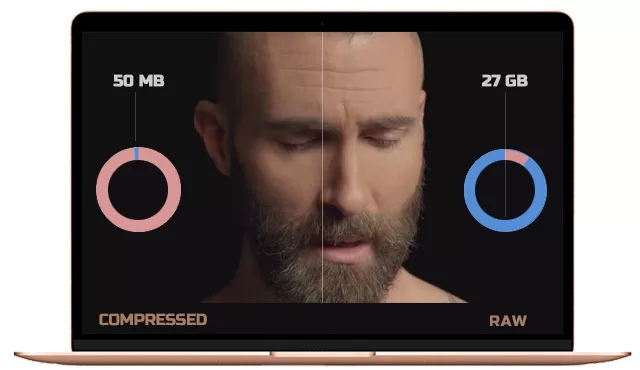
Everybody talks about H.266/VCC and its 30 to 50 percent higher compression ratio, but not enough people dig into the reasons and details lying beneath the surface. Why do people keep moving forward on video coding formats? What makes H.266 better than H.265, H.264, AV1 or VP9?
If you need both a simple conclusion of what life-changing impacts H.266 would have and an in-depth analysis of video compression algorithm improvements, you are at the right place.
The goal of video compression never changes
Video compression standards, especially lossy video codecs like HEVC, H.264, VP9 and AV1, are developed with the intention to cut redundant information without damaging quality much, and ease the burden of bandwidth during data transmission accordingly. The new codec VVC is no exception. As you may imagine, with the advance of video resolution, there might be H.267, H.268, etc in the future for 16K and higher. (Besides encoding videos with such lossy video codecs, there are several other ways for video compression.)
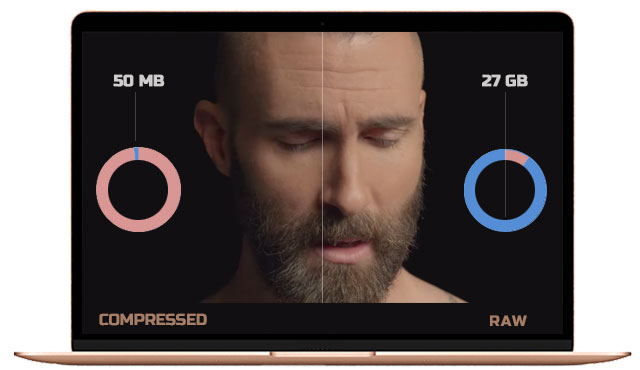
What Is H.266/VVC?
H.266/VVC is MPEG’s next-generation video encoding and decoding standard. It is designed as the successor to High Efficiency Video Coding (HEVC/H.265) for further alleviating stress on large data transmission like 4K, 8K and even 16K UHD videos, as new codec always has been.
Compared with royalty-free video coding formats like AVI and VP9, H.26x series including H.266, H.265, H.264, etc. are proprietary with numbers of patent pool administrators.
The Advantages of H.266/VVC
Normally, one of the reasons that a new video coding standard is worth spreading is due to the huge improvement of video compression algorithm. The higher the compression ratio, the less the bit rate for data transmission, the smaller the file size would be. Then, what are the benefits of H.266?
- H.266 comes with new algorithm, 30% to 50% higher compression rate for the same video quality than HEVC.
- A video file encoded in VVC therefore would be much smaller than in HEVC, let alone in AVC.
- In terms of quality, H.266 now is the one barely any codec can match at the same file size.
- VVC is better for streaming UHD content in 4K, 8K and even 16K on TV.
- Better support for High Dynamic Range (HDR) and 360° video.

Coding Efficiency – VVC vs HEVC vs AV1
What makes the new standard H.266/VVC codec eagerly anticipated is that there is no further tradeoff between file size and quality compared with AV1, HEVC, etc. Namely, same size, better quality. Then what are the exact bit rate savings of VVC? How long does H.266 take to encode a 4K video? Authorities have made the test for us. Check the comparison of video coding efficiency (H.266 vs H.265 vs AV1 vs H.264) below.
To understand the statistics, you need to know:
- VTM and SCM are performance test models for H.266, while HM/x265/NVENC 265 for HEVC.
- BD-rate is used to evaluate coding efficiency, indicating the changing of bit rate and PSNR.
- PSNR, abbreviation of peak signal-to-noise ratio, is widely used as the metric of subjective video quality.
- A negative BD-rate value means reduction of bit rate at the same quality level.
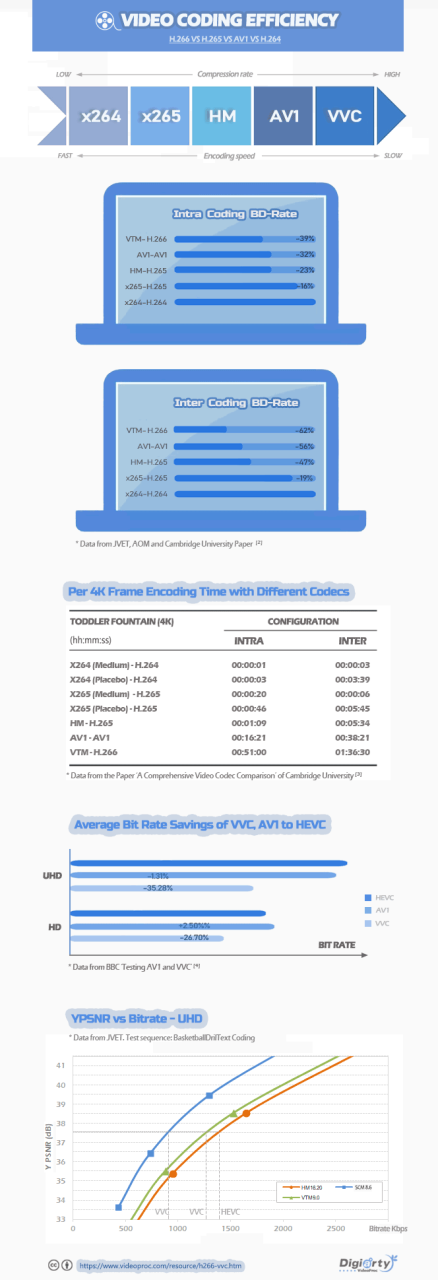
What does the data tell us?
- Coding efficiency: H.266 > AV1 > H.265 > H.264
- Encoding/decoding difficulty: H.266 > AV1 > H.265 > H.264
- H.266/VVC optimizes both Intra and Inter video coding algorithms.
- Roughly speaking, the higher the resolution is, the more bit rate VVC saves.
VVC vs AV1
Actually, there are far more testing data than what we present above. Things are a little different from sequence to sequence. Generally, VVC is superior to AV1 in terms of video coding efficiency, but AV1 is not really far behind. It even exceeds H.266 when dealing with 1080p HD or lower-resolution videos.
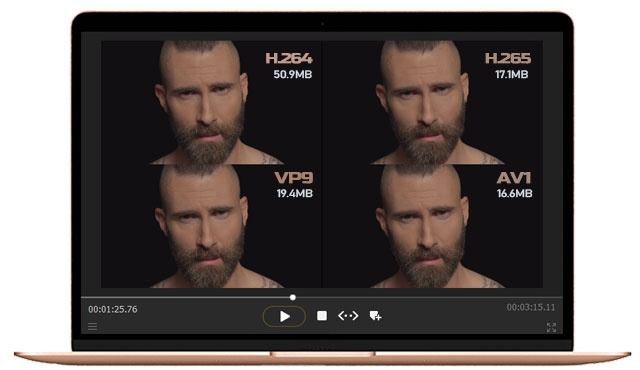
Remember that when you need to conduct a comparison between two codecs, better not use the file re-encoded with video converter software, which might be re-compressed with different settings. Although the file size is smaller, the quality degrades, as the following picture shows.

VVC Coding Algorithm Improvements
Now you know VVC is likely to save up to 50% bit rate while maintaining the same quality, compared to its predecessors and competitors. To be sure, it is a huge leap forward in data compression. If you are interested in taking a deep dive into what exactly contributes to such high video coding efficiency, check the following comparison of intra/inter coding process of H.266, H.265 and H.264.
To understand coding process better, get the basic ideas first:
- Video compression consists of two main parts – intra compression and inter compression.
- Intra compression is to remove spatial redundancy, while inter is to remove temporal redundancy.
- The larger the coding tree unit (CTU) size, the higher the coding efficiency. [5]
- Prediction modes with more candidates and longer interpolation filter improve precision.
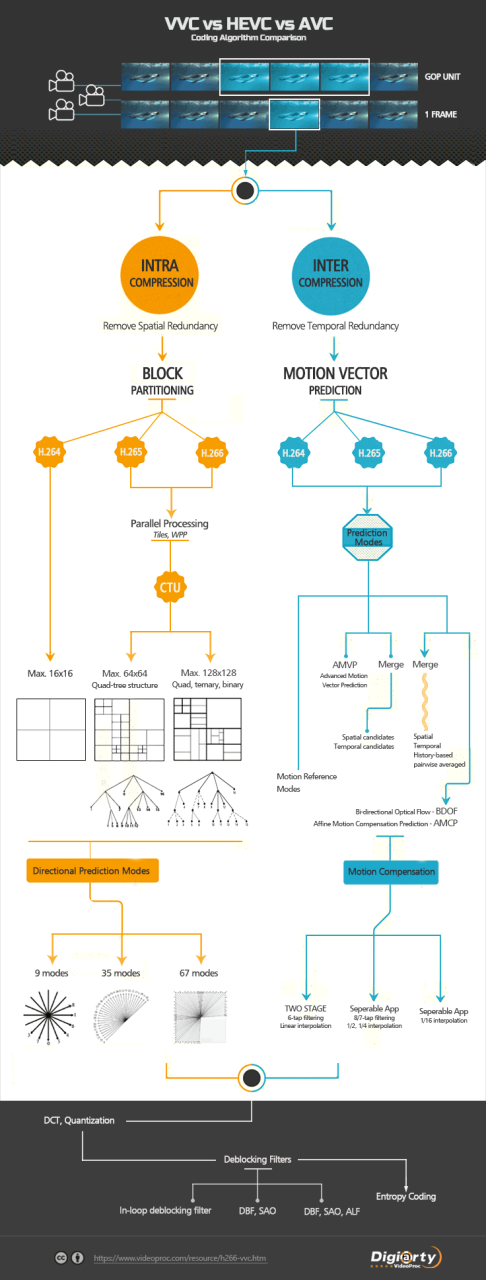
What does the data tell us?
- Both intra and inter coding algorithms are enhanced in VVC.
- Multi-type tree partitioning, including quad-tree, ternary-tree and binary-tree improves coding efficiency.
- A series of new technologies are used to refine inter prediction precision.
FAQ
Which hardware will adopt H.266/VVC?
MC-IF is now developing chips for making it easy to encode and decode H.266/VVC on more smartphones and computers. It is also widely believed that all the companies in MC-IF will be in support first. So the list of supported devices should include Apple TV, iPhone iPad, Huawei products, Samsung TV, Sharp TV, Microsoft Xbox, Nokia, Intel’s video encoding and decoding hardware (CPU and graphics).
Which software will adopt H.266/VVC?
Fraunhofer HHI, the developer company in Germany, will release the first software that supports H.266/VVC. Also, video transcoders are supposed to support this codec in the first time. Video players and editing programs with powerful decoding ability will keep up, sooner or later.
- VVC Video converters: such as VideoProc Converter, WinX HD Video Converter Deluxe, MacX Video Converter Pro, Any Video Converter Ultimate and Pavtube Video Converter Ultimate.
- Video players: 5KPlayer, Pot Player, MPV, MPC-HC, VLC (it requires downloading video codec on github), KMPlayer, etc.
- Video editing software: VideoProc Vlogger, Adobe Premiere Pro, Vegas Pro, Final Cut Pro X, VSDC, etc.
Will H.266/VVC Replace HEVC and H264?
The H.266 codec has an obvious advantage on 4K and 8K videos. With the advent of 5G era and people’s increasing demand of ultra-high resolution image, H.266 technology seems very competitive, especially in the fields of broadcasting, security, education, medical, entertainment, etc.
But things may be not that desirable. HEVC is a negative example: the standard was finalized in 2013, but was not supported by Apple Inc. until 2017. H.264 is still playing a dominant role.
Therefore, it would be 3-5 years before H.266 is generally supported by more hardware and software. Some experts expect that this new codec would not be widely accepted and used until 2027. It is not expected to replace H.264 and HEVC. Instead, we will enter a new era with the coexistence of multiple codecs.
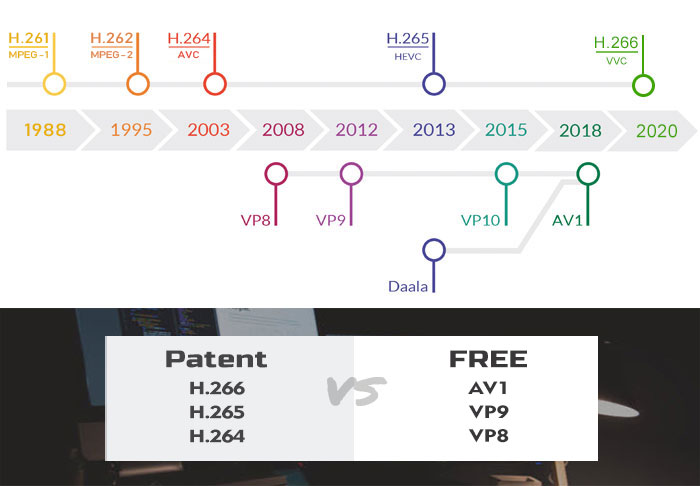
The development of H.266/VVC
From October 2017 when proposals were called for, it took three years to confirm the standard. Many companies involved in and gave support, including Apple, DJI, Ericsson, Intel, Huawei, Microsoft, Qualcomm, Samsung and Sony. A new group called the Media Coding Industry Forum (MC-IF) with 34 members worldwide was founded for avoid the previous licensing issue in HEVC.
HEVC Advance LLC (“Advance”) announced a draft VVC Licensing Program Overview on August 20, 2020. The “Advance Licensing Platform” for Video Codecs is expected to launch next year. This license structure will provide not only a stand-alone “VVC Platform License”, but also a “Joint HEVC + VVC Platform License”. That means, the products with both VVC and HEVC technologies are expected to enjoy a substantial discount. From this respect, the future utilization and popularity of VVC codec will be promising.
Reference
[1] Avg. bit rate (Mbps) = Frame size (width pixels * length pixels * 3 Bytes * 8 bits) * Frame rate / 1024 / 1024
[2] Performance comparison of screen content coding between HEVC and VVC – JVET
[3] A comprehensive video codec comparison – Cambridge University
[4] Testing AV1 and VVC – BBC
[5] HEVC Wikipedia – HEVC bit rate increased by 2.2% when forced to use a 32×32 CTU size, and 11.0% when use 16×16.